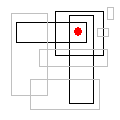|
CGAL 4.14 - dD Range and Segment Trees
|
|
CGAL 4.14 - dD Range and Segment Trees
|

This chapter presents the CGAL range tree and segment tree data structures.
The range tree is theoretically superior to the \( Kd\)-tree, but the latter often seems to perform better. However, the range tree as implemented in CGAL is more flexible than the \( Kd\)-tree implementation, in that it enables to layer together range trees and segment trees in the same data structure.
CGAL::Range_segment_tree_set_traits_2<R>CGAL::Range_segment_tree_set_traits_3<R>CGAL::Range_tree_map_traits_2<R,T>CGAL::Range_tree_map_traits_3<R,T>CGAL::Segment_tree_map_traits_2<R,T>CGAL::Segment_tree_map_traits_3<R,T>CGAL::tree_interval_traitsCGAL::tree_point_traitsCGAL::Range_tree_d<Data, Window, Traits>CGAL::Range_tree_k<Traits>CGAL::Segment_tree_d<Data, Window, Traits>CGAL::Segment_tree_k<Traits>CGAL::Tree_anchor<Data, Window> Modules | |
| Concepts | |
| Traits Classes | |
| Search Structures | |
Classes | |
| class | CGAL::Tree_anchor< Data, Window > |
Tree_anchor is also derived from Tree_base. More... | |